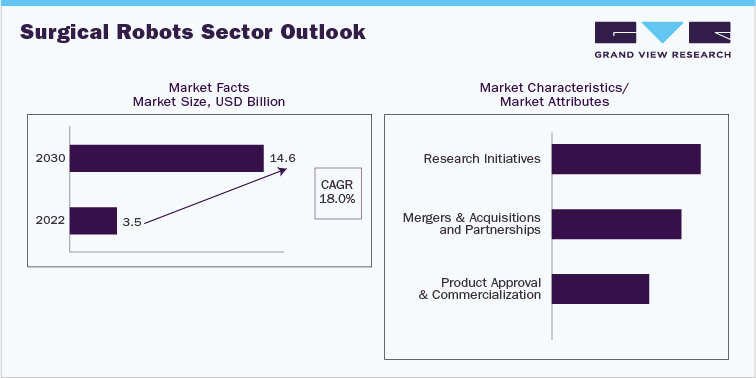
Surgical Robots Industry Data Book Covers Orthopedics and Non- Orthopedics Market. The global surgical robots market was valued at USD 3.5 Billion in 2022 and is anticipated to grow at a CAGR of 18.0 % over the forecast period.
Global surgical robots industry data book is a collection of market sizing information & forecasts, trade data, pricing intelligence, competitive benchmarking analyses, macro-environmental analyses, and regulatory & technological framework studies. Within the purview of the database, such information is systematically analyzed and provided in the form of outlook reports and summary presentations on individual areas of research along with a surgical robots statistics e-book.
North America held the largest market share in 2022, owing to the presence of technologically advanced healthcare infrastructure coupled with the increasing adoption of automated surgical equipment. Furthermore, the increasing prevalence of chronic disorders such as diabetes, cardiovascular disease, and cancer is anticipated to drive the demand for advanced and cost-effective surgical robots in the region. According to an article published by Johns Hopkins University, robotic cardiac surgery is a minimally invasive heart surgery performed with robot-controlled tools and instruments. The procedure is generally called Da Vinci surgery based on the name of the manufacturer of the robot.
Orthopedics Market Analysis & Forecast
The global orthopedics market was valued at USD 805.7 million in 2022 and is anticipated to grow at a CAGR of 12.8% over the forecast period. The growth is attributed to the increasing prevalence of orthopedic conditions, such as degenerative bone disease, the growing geriatric population, and an increasing number of accidents. According to a study conducted by WHO, around 80% of the geriatric population lives in middle and low-income nations. This is anticipated to create a huge opportunity for key players in the market to expand their presence in emerging nations.
Moreover, the early onset of musculoskeletal problems, mostly caused by a sedentary lifestyle and obesity, is expected to drive market expansion. Musculoskeletal diseases affect around 1.71 billion people globally, according to the Global Burden of Disease in 2021. As a result, an increase in musculoskeletal problems is expected to drive the market over the forecast period. Additionally, growing awareness regarding the availability of innovative items is causing hospitals to improve their technology and services frequently. Furthermore, payment coverage for orthopedic therapies has contributed to the adoption of orthopedic procedures.
Order Free Sample Copy of "Surgical Robots Industry Data Book - Orthopedics and Non- Orthopedics Market Size, Share, Trends Analysis, And Segment Forecasts, 2023 - 2030" Data Book, published by Grand View Research
Non-Orthopedics Market Analysis & Forecast
Non-Orthopedic applications of surgical robots include robots for neurology, cardiology, gynecology, urology, and others. The global non-orthopedic market was valued at USD 2.74 billion in 2022 and is anticipated to grow at a CAGR of 19.2% over the forecast period. The growth is attributed to the increasing prevalence of neurological disorders coupled with the rising number of road accidents causing brain injuries. According to the International Brain Injury Association, around one million traumatic brain injuries are treated in the United States every year. Additionally, around 80,000 patients are discharged from hospitals with traumatic brain injury disability.
Furthermore, technological advancements in the field of neurology, urology, and gynecology have eliminated direct human involvement in surgical operations. These devices are reducing the downsides of invasive procedures. Data recorders, HD microscopic cameras, remote navigation systems, motion sensors, transducers, and robotic-controlled catheters are among the most recent advancements. The major market participants are investing much in R&D to develop technologically advanced medical devices. For example, Brain Scientific, Inc. will deliver the next-generation NeuroCap device in March 2021. It is an advanced EEG electrode array that is utilized in clinical and research settings to deliver quick EEGs whenever required. This is anticipated to drive market growth in the coming years.
Furthermore, the increasing prevalence of high blood pressure and diabetes is also contributing to the rising demand for efficient and technologically advanced urology solutions. According to data published by the American Kidney Fund, around 25% of kidney failures are caused due to high blood pressure, and around 38.4% of kidney conditions are caused due to diabetes. The aforementioned factor is anticipated to drive the market demand over the forecast period.
Go through the table of content of Surgical Robots Industry Data Book to get a better understanding of the Coverage & Scope of the study.
Surgical Robots Industry Data Book Competitive Landscape
Increasing demand for surgical robots is increasing competition in the market and, thus, forcing key players to introduce new products of different capabilities in the market. Additionally, it is projected that rising industry consolidation activities, such as acquisitions and mergers by the leading market participants, as well as increasing efforts in R&D of surgical robot applications by key players, are also expected to boost the market share.
Key players operating in the surgical robots industry are –
• Stryker
• Medrobotics
• Smith+Nephew
• TransEnterix Surgical, Inc.
• Renishaw plc.
• Intuitive Surgical
• Medtronic
• THINK Surgical, Inc.
• Zimmer Biomet
No comments:
Post a Comment